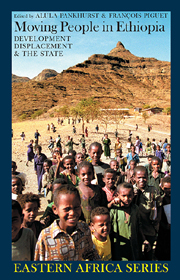Book contents
- Frontmatter
- Contents
- Acknowledgements
- Acronyms
- Glossary
- Notes on Contributors
- Preface: An Original Contribution to Country-wide Displacement Analysis
- Foreword by Alula Pankhurst & François Piguet
- Map
- Part I INTRODUCTION
- Part II THEORETICAL & INTERNATIONAL PERSPECTIVES
- Part III DEVELOPMENT-INDUCED DISPLACEMENT
- Part IV THE EXPERIENCE OF STATE-ORGANIZED RESETTLEMENT
- 9 Why Did Resettlement Fail?
- 10 Social Impact of Resettlement in the Beles Valley
- 11 Revisiting Resettlement under Two Regimes in Ethiopia
- Part V THE DILEMMAS OF REFUGEES, RETURNEES & DISPLACED GROUPS
- Part VI CONCLUSION
- Bibliography
- Index
- EASTERN AFRICAN STUDIES
9 - Why Did Resettlement Fail?
from Part IV - THE EXPERIENCE OF STATE-ORGANIZED RESETTLEMENT
Published online by Cambridge University Press: 05 April 2013
- Frontmatter
- Contents
- Acknowledgements
- Acronyms
- Glossary
- Notes on Contributors
- Preface: An Original Contribution to Country-wide Displacement Analysis
- Foreword by Alula Pankhurst & François Piguet
- Map
- Part I INTRODUCTION
- Part II THEORETICAL & INTERNATIONAL PERSPECTIVES
- Part III DEVELOPMENT-INDUCED DISPLACEMENT
- Part IV THE EXPERIENCE OF STATE-ORGANIZED RESETTLEMENT
- 9 Why Did Resettlement Fail?
- 10 Social Impact of Resettlement in the Beles Valley
- 11 Revisiting Resettlement under Two Regimes in Ethiopia
- Part V THE DILEMMAS OF REFUGEES, RETURNEES & DISPLACED GROUPS
- Part VI CONCLUSION
- Bibliography
- Index
- EASTERN AFRICAN STUDIES
Summary
Introduction
Of an estimated 600,000 people resettled in Ethiopia in the 1980s, over 82,000 were relocated from drought-affected and overpopulated areas to Metekel (Northwestern Ethiopia), a place already inhabited by the Gumuz shifting cultivators. At the time of the resettlement, the population of the Gumuz was estimated at 72,000 (Dessalegn 1988, in Agneta et al. 1993:256-7). Of the total 250,000 ha of land designated for resettlement, over 73,000 ha was cleared for cultivation and the establishment of 48 villages. In 1986, large-scale development programmes were launched with financial and technical assistance from the Italian government. In the late 1980s, the resettlement area was portrayed as an oasis in the middle of wasteland. Salini Costruttori (1989: 14), a contractor for the Italian cooperation, reported, ‘Food self-sufficiency represents the prime objective of the Tana-Beles Project. This objective has already been reached, at the end of 1988.’ Today, the once popular Metekel (Pawe) resettlement is nothing but a failed project and a reminder of despair.
This chapter examines the 1980s resettlement to find out why the project failed and what lessons could be learnt. The outstanding flaws and deficiencies may be summarized as follows. The Pawe resettlement lacked clear conception, a feasibility study, proper planning, adequate physical preparation and responsible management.
- Type
- Chapter
- Information
- Moving People in EthiopiaDevelopment, Displacement and the State, pp. 119 - 129Publisher: Boydell & BrewerPrint publication year: 2009

